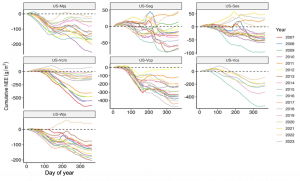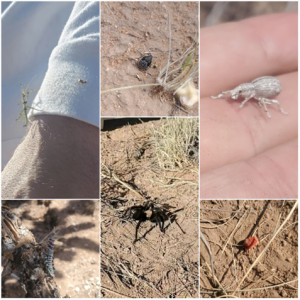5. Drylands play a critical role in regulating the global carbon cycle Drylands account for over 40% of terrestrial land cover, and are expected to increase to nearly 55% by 2100. This large land area combined with large inter-annual variability in net carbon balance, position drylands as critical players in the global carbon cycle.
4. Extremes in climate and ecosystem function. Drylands experience extreme variability in climatic conditions, which range from freezing and snowy winters to hot summers with prolonged periods of drought and/or intense monsoons. These wide ranging conditions drive high variability in ecosystem function, including both high inter- and intra-annual variability of Net Ecosystem Exchange of CO2 (Fig. 1). We love the large spectrum of extreme conditions we experience!

Cumulative NEE for all sites in the New Mexico Elevation Gradient.
3. Dryland organisms are tenacious. Organisms in drylands have developed diverse adaptations to ensure survival in response to extreme climate variation, particularly with respect to limited water availability. Some species exhibit strong stomatal control, some have shallow roots spread close to the surface in order to quickly take advantage of water when it becomes available (e.g. many C4 grasses at US-Seg, Fig. 2), while others have much deeper root systems to access more stable water sources (e.g. piñon, juniper, US-Wjs, US-Mpj, high elevation conifers (US-Vcp, US-Vcs). Some species (e.g. creosote, US-Ses) are drought deciduous, dropping leaves during the most intense droughts. Vegetation in these ecosystems is dynamic, and as a result, these ecosystems are endlessly changing and therefore an endless joy to study.

Phenocam images from US-Seg taken ~2 weeks apart in 2018, showing rapid greenup (right) following a precipitation event.

Some of the many amazing insects you can find on the Sevilleta National Wildlife Refuge (US-Seg, US-Ses). TL: Stick bug, BL: Barber Pole Grasshopper (Dactylotum bicolor), TM: Seed Bug, BM: Tarantula, TR: Weevil, BR: Giant Velvet Mite.
2. Drylands have diverse organisms (plants, biocrusts and amazing bugs)! Drylands encompass diverse biomes ranging from grasslands to woodlands that cover much of the Southwestern US. Lower elevation ecosystems are primarily made up of C4 dominated grasses and creosote. As you move up in elevation, woody species are more abundant with juniper in lower elevations and piñon pine, ponderosa pine, aspen, white fir, subalpine fir and Engelmann spruce increasing with elevation. Drylands also have an active and fascinating layer of mosses, cyanobacteria, lichens, algae, and microfungi that live on the soil surface and provide numerous functions including soil stabilization and fertility. Notably, although we have very few mosquitos, biting flies, and ticks, dryland insects are awesome (Fig 3). The Sevilleta region surrounding US-Ses and US-Seg is, in fact, a bee diversity hotspot, with the longest continuous bee monitoring project (see here!). Besides being cool to look at, they all provide a diverse array of ecosystem function.
1. Drylands provide outstanding views and LOTS of sunshine. With no tree line in the drylands, the views are vast and incredible. Even during winter, drylands are a sea of undulating golden brown seed heads and last year’s leaves on a backdrop of blue sky and purple mountains. The views are incredible from the early morning sunrise, through the golden and pink sunsets, it’s an incredible place to work.

Left: Field trip to US-Seg. Right: Our fearless technicians Rachael Auer and Jake White at US-Vcm.

No Comments
Be the first to start a conversation